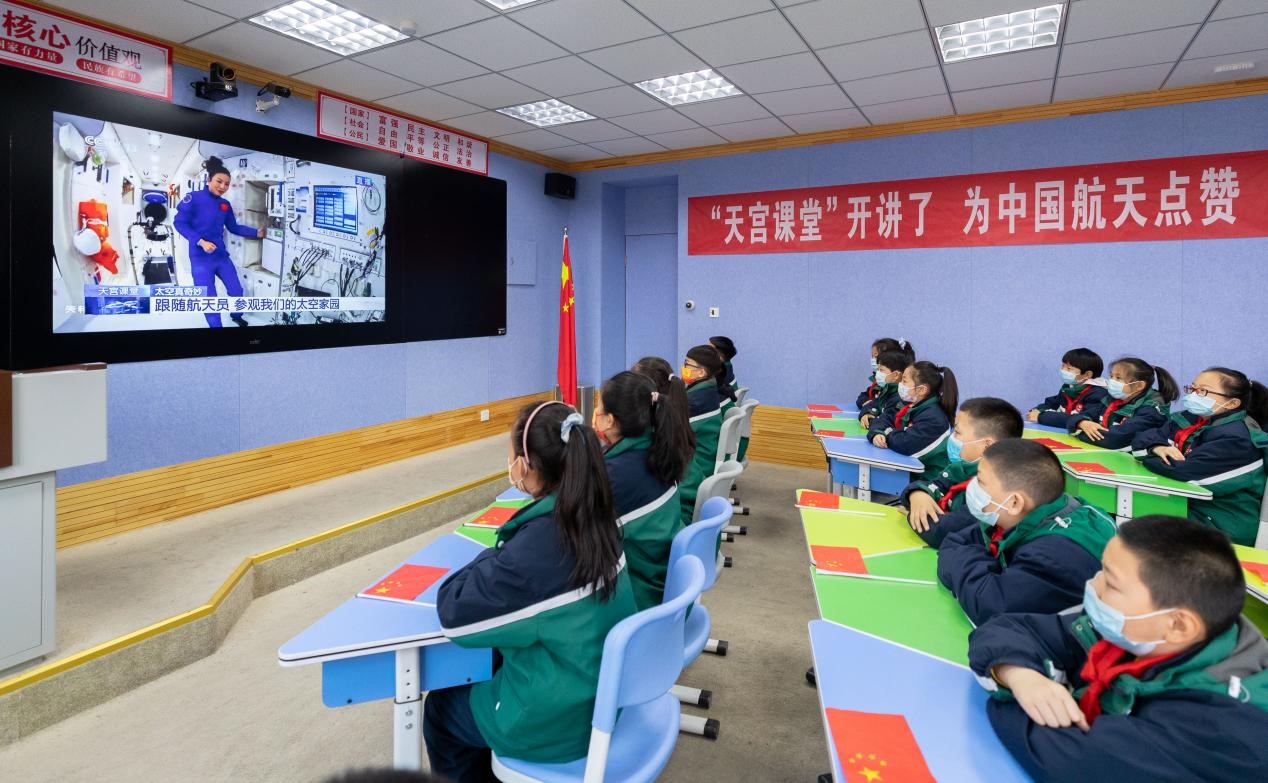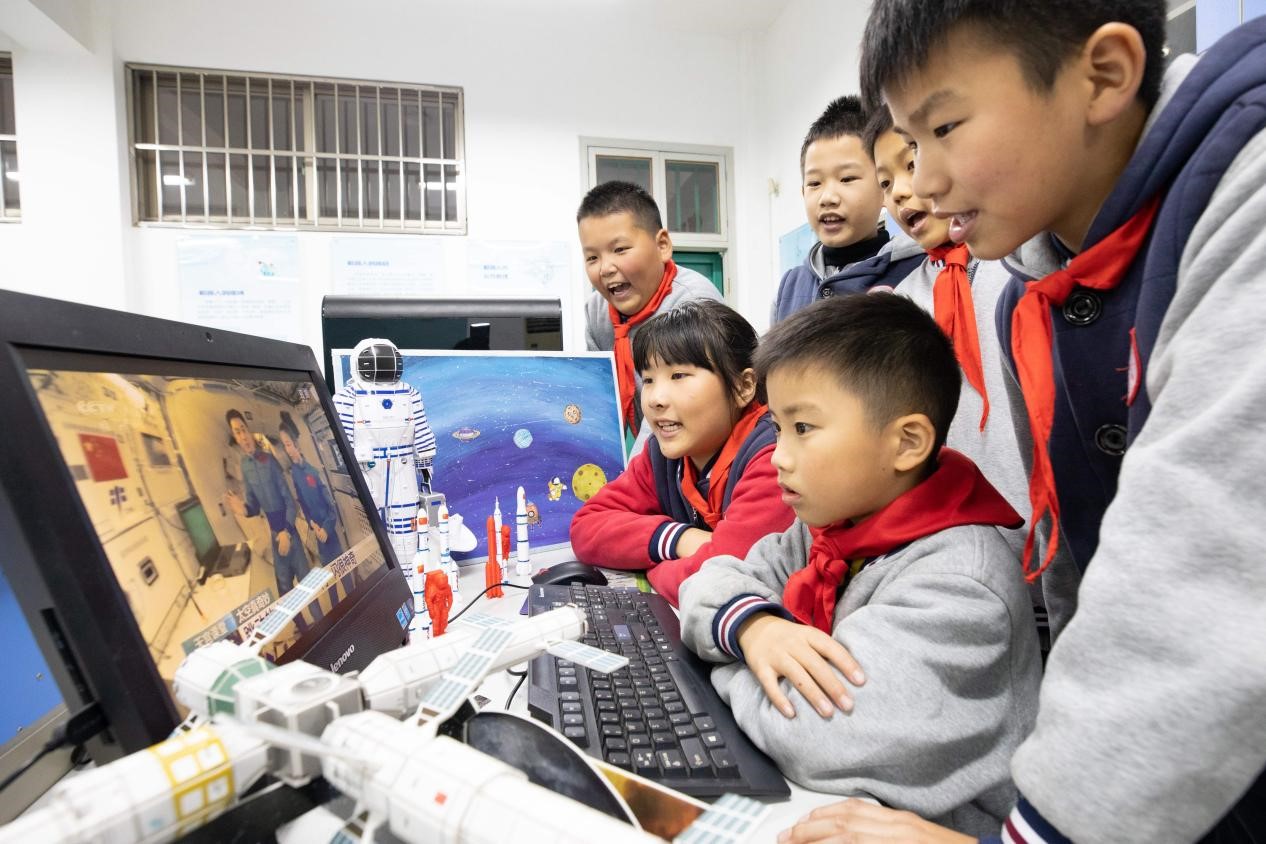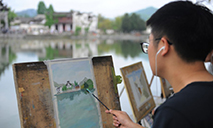Shenzhou-13 crew gives first science class from China’s space station
On Dec. 9, crew members of China’s Shenzhou-13 manned spaceflight mission, Chinese astronauts Zhai Zhigang, Wang Yaping, and Ye Guangfu, delivered a wonderful 60-minute science class 400 kilometers above Earth at China’s Tiangong space station to elementary and middle school students.

Students at an elementary school in Yuquan district, Hohhot city, north China’s Inner Mongolia autonomous region watch a livestreamed science lecture given by crew members of China’s Shenzhou-13 manned spaceflight mission from the country’s space station, Dec. 9, 2021. (People’s Daily Online/Ding Genhou)
The livestreamed lecture was the first lecture conducted by Chinese astronauts from space in eight years since the last space class was given in 2013, and also the first lecture given from China’s space station.
At the main classroom set at the China Science and Technology Museum, students interacted with their “space teachers” in real time via a large screen.
As the live scene on the screen shifted from the space station orbiting the blue Earth to the roomy and uncluttered core module of the space station, a spinning yellow top appeared on the screen, which was followed by an introduction to the lecture made by Wang.
“There is no end for space exploration. As the top spins continuously, we have moved from the Shenzhou-10 mission to the construction of China’s space station. Welcome to the ‘Tiangong Class’,” said Wang, greeting students attending the class in different cities of the country. She then introduced to students her crewmates, Zhai and Ye, who also said hello to the whole class.
Wang gave students a virtual tour of the brightly lit core module of the Tiangong space station. The sleeping zone of the core module is equipped with three bedrooms. With photos of her family and some little ornaments, Wang’s bedroom looked warm and sweet. The porthole in the bedroom gave a splendid view of the universe and Earth.

Photo taken on Dec. 9, 2021 shows students at an elementary school in Korla city, northwest China’s Xinjiang Uygur autonomous region watching a livestreamed science lecture given by crew members of China’s Shenzhou-13 manned spaceflight mission from the country’s space station. (People’s Daily Online/Yang Kun)
“In zero-gravity environment, our blood distribution is different from that on Earth. Blood in the lower part of our body flows upward, so we look a little chubby and puffy. It can affect our health. Therefore we need to counter the physiological effects of weightlessness through a lot of exercise methods,” Wang said. She showed students how to use treadmill and spin bike in space.
In the kitchen of the core module, which is equipped with devices like microwave, water dispenser and refrigerator, Wang took out a fresh apple from the refrigerator.
The water dispenser is used to draw water for drinking and cooking, according to Wang, who said that with technological advances, the space station has realized regeneration of water for drinking and cooking and that every drop of water is made full use of in the space station.
Ye and Zhai demonstrated to students how they resist the physiological effects of weightlessness in space during the class.
Besides exercise equipment, astronauts also have a “secret weapon” that can help prevent muscular atrophy caused by weightlessness, said Zhai, referring to the “penguin jump suit” Ye was wearing during the class.

Students of an elementary school in Changxing county, Huzhou city, east China’s Zhejiang province watch a science lecture delivered by crew members of China’s Shenzhou-13 manned spaceflight mission from the country’s space station, Dec. 9, 2021. (People’s Daily Online/Zhou Hongfeng)
It has multiple elastic bands inside to help the astronauts maintain their muscle strength, said Zhai, who considers the suit a valuable fruit of the ingenuity of space science and technology experts.
During the class, students in the classrooms on Earth put a ping-pong ball in a glass of water and the ball floated. When Wang did the same thing in the space station, the ball stayed in water. “The reason is that buoyancy almost disappears in zero-gravity environment,” Wang explained.
“Can we send an e-mail to you?” a student attending the class from a classroom in China’s Macao Special Administrative Region asked.
“We can communicate with the ground control by e-mail and video call from the core module. In our spare time, we are able to watch movies, read novels and listen to music. We also have a lot of TV channels here. We can also have two-way phone calls with our family during the weekend break. Currently, since our e-mail to the ground team requires special handling, we can’t receive your e-mail now. But you can leave messages for us online, and we are looking forward to your comments,” Ye answered.
Photos
Related Stories
- China to openly select sci-tech projects for space station cargo craft
- Wang Yaping, first woman taikonaut to enter China's space station
- China welcomes foreign astronauts to space station flights
- China announces Shenzhou-13 crew, including first female to space station
- China unveils Shenzhou-13 crew for six-month space station mission
- China unveils Shenzhou-13 crew for space station mission
Copyright © 2021 People's Daily Online. All Rights Reserved.










